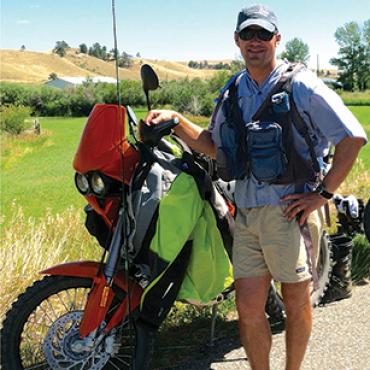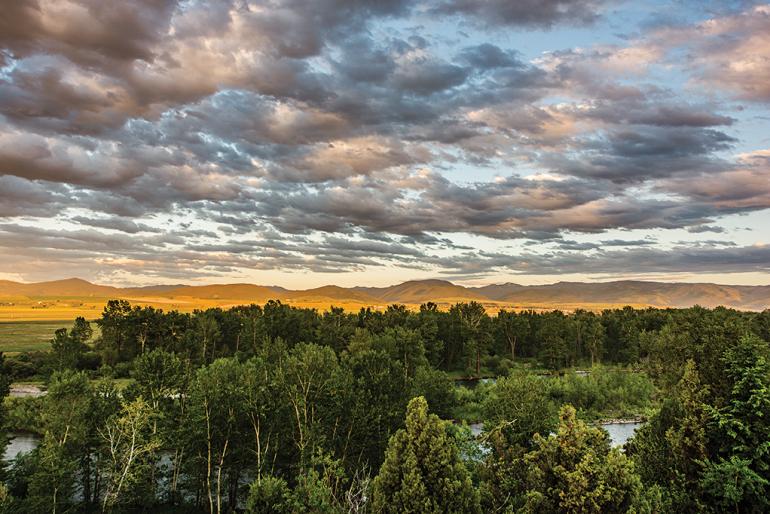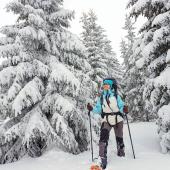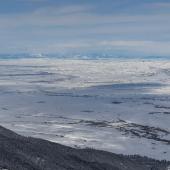Beyond Public Access
Why conserving private land is good for all.
When I moved to Bozeman in the mid-’90s, I felt as though I was ahead of the curve, like I’d “discovered” one of the best places on the planet for the lifestyle I wished to live. The sine qua non for this life I had in mind was not entirely explicit at the time because it was so readily visible, aesthetically accessible, and expansive. The thought of it disappearing due to over-development was preposterous.
The centerpiece I am referring to is open space: land that, save a family ranch house and a couple of 20th-century barns, is undeveloped. No grove of McMansions with requisite trout pond, teepee, and freshly minted NO TRESPASSING signs from Ace Hardware adorning every property corner. Land that seemed to open its arms and welcome you, inviting you—nay, urging you—to roam and explore, like the deer in the grass and the hawks soaring high overhead.
But I was a naive and ignorant college student in his early twenties romantically envisioning himself living the life of Jeremiah Johnson. In my eyes and in those of my peers, the landscape and access to it was without limitation. Whether in the Gallatin Valley or throughout the more rural parts of Montana, we ventured freely with rod, gun, bike, or backpack, enjoying the world-class recreation in a somewhat primitive landscape.
As those of my ilk came pouring into the inhabitable areas of Montana, longtime residents who owned the land were already figuring out how to conserve it. They wanted to protect the very thing so many of us had moved here for: beautiful and accessible landscapes and the natural features they harbored—rivers and streams, birds and trout, deer and elk.
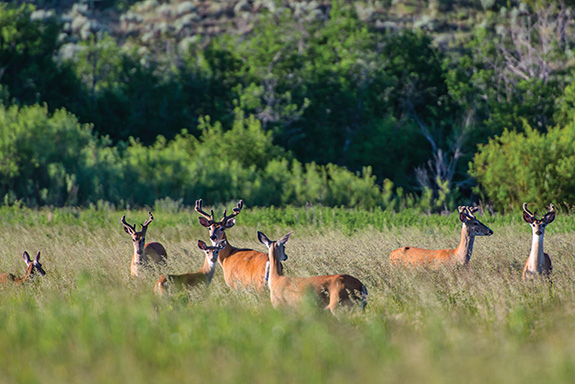
Driving back and forth to the Gallatin in the days before there was a steady line of cars heading the same direction, I remember seeing the iconic bumper stickers—“Cows not Condos”—and wondering what that was all about. It has taken me almost 25 years to figure out that the Montana Land Reliance (MLR) was behind those popular bumper stickers, a campaign to protect land in Montana in the form of conservation easements on private property.
Thanks to the efforts of MLR and other land trusts like the Gallatin Valley Land Trust, we do see more cows and fewer condos than we would otherwise. There are now 2.6 million acres of conservation-easement-protected lands across the state, and MLR holds the easements on a million of those acres. Though I’m sure there are many young people moving here now, fresh from an urban area, whose perspectives are as warped as my own was, for those of us who have been here awhile, the landscape we once knew is disappearing at a rate that is more than just alarming; it’s disorienting, disturbing, and terrifying. By now, if you count yourself as someone who values the scenic landscapes and plentiful outdoor recreation and you’re not doing all you can to conserve what’s left of it, you’re either in a hopeless state of denial, depressed and apathetic, or locked up in Deer Lodge for an act of road rage.
For those of us who are on the path of conservation and interested in spending our time, energy, and dollars to the greatest effect possible, what does a land trust like the Montana Land Reliance have to offer? It’s unlikely that we’ll ever have the means to own a large piece of ground—and besides, don’t easements just assist already-wealthy landowners by giving them tax breaks to keep their land out of development? So these privileged few get to keep their land in perpetuity and keep the public out of it, saving the rarified recreational opportunities found there for family and close friends? The general public loses again, right?

After spending an afternoon with Kathryn Kelly, the Greater Yellowstone manager of the Montana Land Reliance, on her family ranch along the Gallatin, I learned why supporting MLR is worth considering for all stakeholders. Kathryn and her parents worked with MLR to place a conservation easement on their place a decade ago, forever protecting its wildlife habitat, water resources, productive agricultural land, and cultural heritage, both Native American and pioneer settler. The ranch features two miles of the Gallatin River, several historic buildings constructed from materials that came off of the property, and even a buffalo jump with archeological treasures. The experience of permanently protecting the family ranch through a conservation easement was so positive, powerful, and beneficial that it inspired Kathryn to help others do the same.
Walking the property’s high bluffs with Kathryn, as she explains what MLR does and how conservation easements work, I can look across the valley and see what has happened to farms and ranches that were not placed into conservation easements. Thousands of acres have been lost to subdivisions and strip malls. Given the rise in real-estate values in and around Bozeman in the past decade, the potential development value of open land is staggering.
And so, I now realize, is the virtue of landowners who eschew the absurdly lucrative offers from developers in favor of placing their properties into conservation easements. It would be so easy to sell out given the record-setting pace of growth in the Gallatin Valley—to cash in all your chips, create a trust that would maintain your family’s wealth for generations, and head south; or even simply buy another, bigger ranch in a less-fashionable part of the state.
While Kathryn and I walked the property, we saw sandhill cranes and bald eagles. Songbirds of all kinds started their evening chorus while whitetail deer emerged from the cottonwoods and grazed the hayfields along the river. Meanwhile, several mountain bikers and a couple of trail runners moved along the rural dirt road, smiles on their faces, their eyes wandering about, taking in the beauty of the landscape and scenery. Shortly thereafter, a family came by in a Jeep with the top down. All had probably left the newly developed suburbs to tour through this scenic and serene landscape which largely consists of privately held land, still there because of the work of MLR.
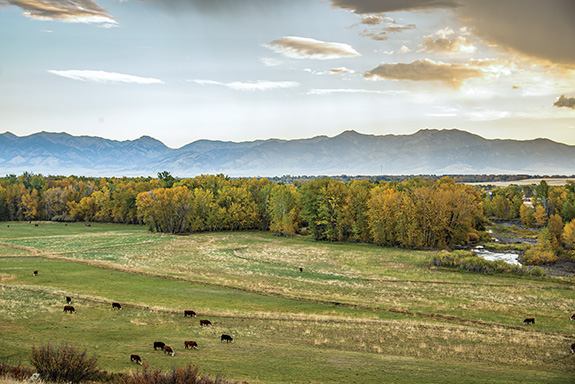
I also came to find out that our local chapter of the Audubon Society regularly frequents the Kelly family ranch, as does the local native plant society, leading tours in regional flora and fauna. Up to seven species of bats have a sanctuary on the ranch, and the riparian zone and streambanks along the Gallatin are preserved for fish and wildlife. Plus, the land continues to be a working cattle ranch. Kathryn made the point that while some landowners of a protected property may not be comfortable with the idea of public access, that land is conserved forever and future landowners have the opportunity to increase access as they see fit. If the land is turned into a subdivision, that chance is lost forever.
Something else Kathryn explained to me is that not all privately held land will ultimately qualify or be appropriate for a conservation easement. MLR is strategic about its acquisitions to establish the most effective approach to conservation in the area. For example, preference is given to property that serves as a vital link for wildlife habitat or is in possession of a considerable length of stream or river frontage. Productive agricultural land also qualifies. And this is another way the public benefits from private-land conservation: these large tracts provide untrammeled habitat for public fish and wildlife to flourish and fertile ground for local food production.
Something Kathryn mentioned that really got my attention was how she has worked on several easement projects across the Greater Yellowstone Ecosystem that involve reconnecting multiple 20-acre ranchette parcels from rural subdivisions where owners never built. Some of these lots exist in important wildlife corridors. The end-goal is to remove all vestiges of the lots and reestablish the original character of the property. Evidently, with enough creativity and hard work, a land trust like MLR can move beyond simply conserving what is already there to reclaiming what once was—yet another essential effort given the rampant development of our state’s trademark open land.
When it comes to private-land conservation efforts, for anglers, kayakers, and river-recreators of all kinds, something else to consider is what you see as you float down a river corridor, and how that affects your experience. For anyone who remembers floating through the Paradise Valley 30 years ago, today’s view of mansions, gazebos, and putting greens along the banks of the river has so reshaped the experience that one almost wishes to look at nothing besides his strike-indicator. In contrast, much of the Madison River corridor has already been placed into conservation easements with MLR and there are more currently in the works. This is why the viewshed there is largely still intact. Private-land easements support the continued viability of regional outfitters and guides, fishing and otherwise. Anglers who travel to float on the rivers and streams of southwest Montana count on experiencing scenic beauty along with decent fishing and floating. By keeping river corridors and their surrounding landscapes from becoming a haven of garish ostentation, private-land conservation helps to maintain the original charm and character of Montana—character from which locals benefit, and for which visitors are willing to pay.
Driving back from the Kelly Ranch, working my way through car dealerships, subdivisions, and shopping centers amidst rush-hour traffic in the bustling Gallatin Valley, the overarching need for land conservation became poignantly clear. Equally obvious is the need for an effective strategy in this effort similar to that of MLR, GVLT and other land trusts, which doesn’t just shout “Cows not Condos!” but works diligently, intelligently, and cooperatively to piece together segments of land that can best conserve what we value most: scenic landscapes and rivers; the fish and wildlife that inhabit them; the heritage, values, and sense of place that comes with open space; and a reasonable amount of access to all of that. Isn’t that why we all moved here in the first place?


